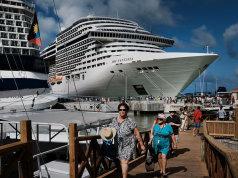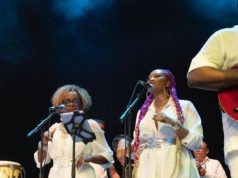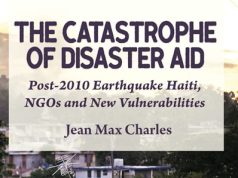

Esther Whitfield’s A New No-Man’s-Land: Writing and Art at Guantánamo, Cuba was published by the University of Pittsburgh Press in 2024. Here are excerpts from a comprehensive review by Jacqueline Loss (University of Connecticut). To access the full review, visit NACLA.
Esther Whitfield’s new book, A New No-Man’s-Land: Writing and Art at Guantánamo, Cuba, is profoundly poetic and ethically resonant. The work opens with an unusual expression of gratitude for “iguanas, cats, banana rats, hummingbirds, the sea, and woodpeckers” by Mansoor Adayfi, a writer, advocate, and former detainee who spent 14 years imprisoned at the Guantánamo Bay detention camp. Through these creatures, Adayfi found a way to navigate the disorienting and painful reality of prolonged imprisonment, drawing solace and resilience from the natural world around him. Throughout Whitfield’s book, she addresses the enduring question of art’s role in confronting atrocities, including the stripping of an innocent man’s freedom in the name of the war on terror. Whitfield’s analyses of borderland writing, visual art, and documentaries by people who live in the province of Guantánamo, Cuba, and by prisoners in the Guantánamo Bay Naval Base (GTMO) U.S. detention camp reveal unexpected continuities and slippages in experiences of repression, suggesting that these ostensibly “enemy” forces share a common drive for discipline and, above all else, control.
[. . .] Whitfield’s book dismantles any notion of separation of the so-called local and global spheres from the outset with cover art by the Guantánamo-born artist Alexander Beatón titled “Para que la verdad sea creíble tiene que ser vigilada” (For the Truth to be Credible it Has to be Guarded), an apt phrase for addressing the mirage that constitutes ideology. The image, featured in a 2021 exhibit by the artist, displays a guard tower in the center of a game of dominos, underscoring how everyday Cuban activity is conditioned by the presence of repressive apparatuses, whether attached to the Cuban state or U.S. imperialism.
Whitfield’s book provides a new vision for a global, cosmopolitan political feeling—one that defies conventional notions of empire, authoritarianism, or their discontents—by enacting a pragmatic and honest approach toward dialogue between diverse entities, each contributing some form of good, even if not all their actions are commendable. For example, while the Guantánamo base represents an obvious wrong, the Cuban revolutionary state’s vilification of its own migrants over the past six and a half decades, even threatening to take away their citizenship, is another form of injustice also worthy of scrutiny and condemnation. Likewise, Cuban literature, whether produced on or off the island and labeled “dissident” by state forces, should not have its literary merit or testimonial value diminished on account of support it may receive from U.S. organizations with ideological positions that differ from our own. Whitfield’s critique demonstrates how these works can still serve as powerful testimonies to the Cuban state’s violence against its citizens.
More than just a critical work, this book is a compassionate exploration of human relationships forged in the most unlikely of places. Whitfield goes to great lengths to create a singular and comprehensive textual and visual archive—one that, without her patient yet bold approach, could never have come into being. She demonstrates that “care” is not just an external concept reflected in the poetry, visual art, and films she brings to light but is also deeply embedded in her approach to those who have endured violence. It is as if her critical method takes its cues from the detainees’ approaches to life. By focusing on acts of care, Whitfield engages in a methodology of care that helps her construct a transnational community through her research and translation project. [. . .]
This book would have been groundbreaking even if it had focused solely on the cultural production of Cubans in the Guantánamo province. It challenges the prevailing tendency to position Havana at the center of Cuban literary discourse—an all-too-common bias in cultural scholarship on Cuba. In the concluding chapter, “Future,” Whitfield uncovers and juxtaposes materials rarely accessible beyond their local context, often preserved in the personal libraries of authors and editors. She brings together El futuro (1994–1996), a publication created by Cuban refugees held at Guantánamo as a result of the Balsero crisis, with Porvenir (2008–) from the dissident group Alianza Democrática Oriental, thoughtfully exploring the shared aspirations and tensions between Cuban refugees and dissidents. Whitfield then situates these within a broader constellation of future-oriented projects related to this “same” space, including the Guantánamo Public Memory Project, the Guantánamo Bay Museum of Art and History, and the volume Remaking the Exceptional: Tea, Torture, and Reparations / Chicago to Guantánamo, co-edited by Amber Ginsburg, Aaron Hughes, Aliya Hussain, and Audrey Petty. Weaving together firsthand accounts of hardship with imagined visions of future restoration—whether as reparations or a marine reserve—is a bold move, one of many ambitious choices that define this text. [. . .]
Esther Whitfield is associate professor of comparative literature and Hispanic studies at Brown University. She is author of Cuban Currency: The Dollar and ‘Special Period’ Fiction and coeditor, with Jacqueline Loss, of New Short Fiction from Cuba and, with Anke Birkenmaier, of Havana beyond the Ruins: Cultural Mappings after 1989. With Katerina Gonzalez Seligmann, she translated José Ramón Sánchez Leyva’s poetry collection, The Black Arrow.
Read full review at https://nacla.org/new-no-mans-land-writing-and-art-guantanamo-cuba-review
For purchasing information, see https://upittpress.org/books/9780822948155/
Esther Whitfield’s A New No-Man’s-Land: Writing and Art at Guantánamo, Cuba was published by the University of Pittsburgh Press in 2024. Here are excerpts from a comprehensive review by Jacqueline Loss (University of Connecticut). To access the full review, visit NACLA. Esther Whitfield’s new book, A New No-Man’s-Land: Writing and Art at Guantánamo, Cuba, is profoundly poetic





